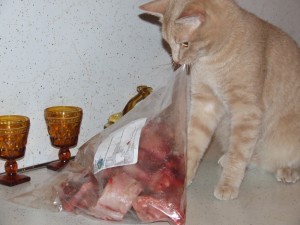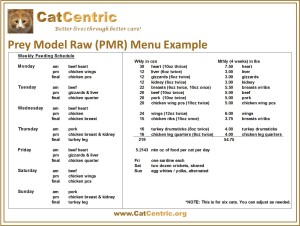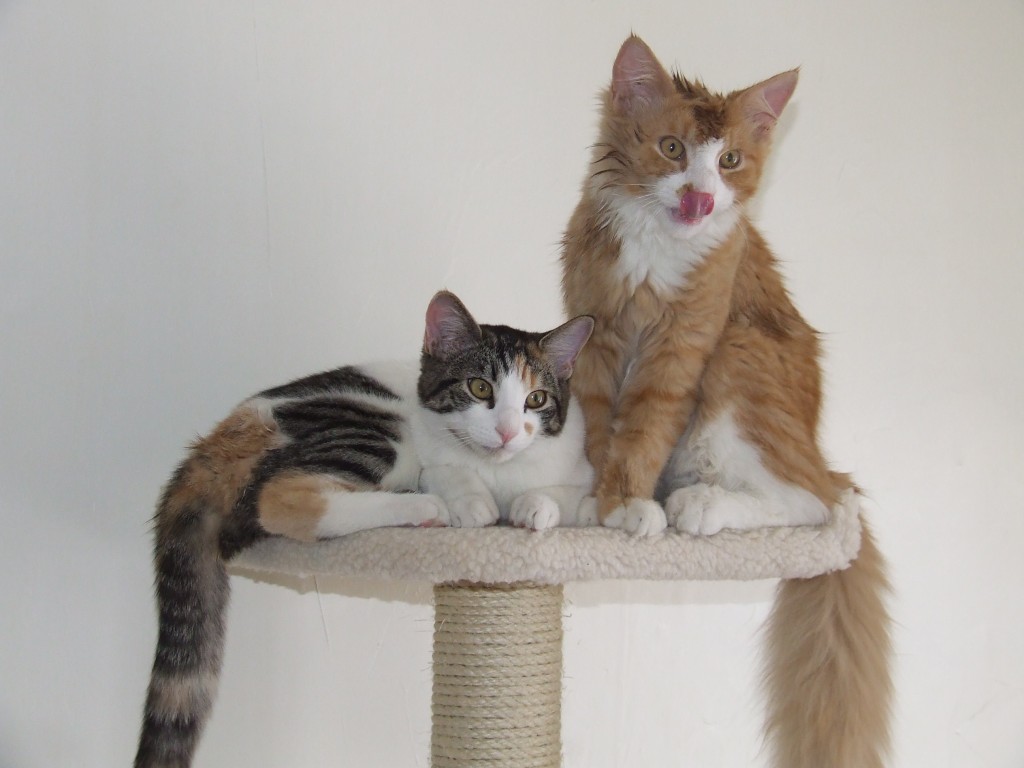 As long time readers know, I’m a huge proponent of prey model raw (PMR) feeding. No other raw diet – commercial or home-prepared – beats it for cost and only whole prey beats it from a nutritional standpoint.
As long time readers know, I’m a huge proponent of prey model raw (PMR) feeding. No other raw diet – commercial or home-prepared – beats it for cost and only whole prey beats it from a nutritional standpoint.
But how do I know the PMR diet I use and recommend is, in truth, providing everything that cats need? I’ve conducted extensive research over several years and I accept that the thousands of cat owners who have been successfully using the PMR guideline for decades is evidence enough that a model this close to the natural diet is sufficient, but proving that to those who want more than just my word on it has been problematic. They want proof, and not from a common sense, historic, or case study perspective, but wholly from a numbers approach, and preferably using AAFCO guidelines as a benchmark.
AAFCO uses chemical and / or ingredient analysis in lieu of nature’s model (i.e. the cat’s natural diet) for determining a homemade diet’s suitability, and I’m not a fan of this type of analysis.
In the first place, science has barely scratched the surface of feline nutrition. Even the National Research Council’s (NRC) latest edition of the “Nutrient Requirements of Dogs and Cats” admits there are large gaps in our knowledge. There is so much we don’t know about the makeup of the cat’s natural diet: we don’t know the full complement of nutrients present, or in what quantity or combinations they exist, nor do we know how much of those nutrients are utilized, individually or synergistically, by the cat. How can we possibly believe we can label a diet “complete” from a nutrient perspective when our knowledge contains so many missing pieces?
Also, although the original NRC guidelines were created using fresh foods, AAFCO diverged from the NRC in 1995 to create guidelines more friendly to pet food product manufacturers, and for the last 20 years or so, AAFCO (and with their latest revision in 2006, even the NRC) product tests and guidelines have been conducted and formulated SOLELY for manufactured products.
Therefore, existing AAFCO and NRC nutrient profile numbers are based upon the consumption of a heavily processed, synthetically supplemented diet, with the awareness of – and compensation for – the destruction of some percentage of those supplements during the manufacturing process, as well as the relevant reduced ingredient bio-availability.
In other words, those numbers are inflated when compared to what would be found in the cat’s natural diet.
By default, then, a fresh diet will always look deficient when measured by AAFCO standards.
So you can see why I have very little use for these manufactured numbers. From a fresh, whole foods perspective, they are, in my opinion, completely irrelevant.
The Analysis

That said, I had my prey model diet – the diet I fed my own cats for many years and have continued to recommend to others – analyzed by Nutricomp, a privately owned database analysis program designed specifically for analyzing homemade pet diets, using USDA data, and compared it to AAFCO’s 2016 minimum recommended allowances for commercial pet food products.
And here’s how it measured up against those inflated numbers…
(read the full analysis here)
Within Range
Macronutrients
All macronutrients – Protein, Fat, Carbs, Fiber and Ash – measured within AAFCO’s recommended range.
Minerals
Phosphorus, Potassium, Sodium, Magnesium, Zinc, and Selenium all measured within range.
Vitamins
Most of the vitamins – Vitamin A, Thiamin, Riboflavin, Pantothenic Acid, Niacin, Vitamin B6, Folic Acid, and Vitamin B12 – also fell within AAFCO’s allowances.
Amino Acids
All but two of the amino acids also registered within range, as follows: Arginine, Histidine, Isoleucine, Leucine, Lysine, Methionine and Cystine, Phenylalanine, Phenylalanine & Tyrosine, Tyrosine, Threonine, Trytophan, and Valine.
Higher Than Range
The only measurement that exceeded AAFCO’s guideline recommendations was the amino acid Methionine. This isn’t of concern, however, as Methionine toxicity studies were conducted using supplemented methionine (the form that pet food manufacturers use in their products), not the naturally occurring methionine found in fresh meat. According to the “Nutrient Requirements of Dogs and Cats”, naturally occurring methionine is peptide-bound and “less toxic than that provided in the free form [supplemented]. Thus, it is unlikely that cats eating natural prey would exceed the safe upper limit for methionine.” Given that prey model diets are also based on fresh meat products, the same should hold true for them.
Lower Than Range
As expected, several nutrients fell below AAFCO’s recommended thresholds.
Minerals
Four minerals – Iron, Copper, Manganese, and Calcium.
If desired, the iron and copper can be brought up to meet AAFCO’s minimums simply by substituting beef liver for the chicken liver used in the example PMR menu.
Manganese studies were conducted on omnivorous pigs, not carnivorous cats, so no one’s truly sure how relevant they are. And according to “The Nutrient Composition of While Vertebrate Prey (Excluding Fish) Fed in Zoos”, the poor bio-availability of Manganese when sourced from plants – as it often is in commercial diets – “is responsible for the elevated requirement of this nutrient.” Therefore, though the numbers may indicate this diet is low, it almost certainly meets the cat’s actual dietary needs.
Calcium is a bit trickier. We know from several studies the percentage of bone in a cat’s natural diet (6-10%), and the USDA numbers tell us the percentage of bone in chicken wings (48%) and other products, so with that we can start with the cat’s average natural percentage of bone, 7%, and then adjust from there based on each individual cat’s response. (Side note: Dr. Pierson, of CatInfo.org, uses these same calculations in her ground recipe.) As with the Manganese, the issue of digestibility comes into play here, and it’s more important to be sure the cat is getting the amount of whole bone as determined by her specific requirements than that the calcium ingested match a specific AAFCO number.
Vitamins
The Vitamins D, E, and K, as well as Choline, all came in a lower than AAFCO’s allowances.
The cat’s requirement for Vitamin D is pretty small – only .4 micrograms – and the USDA Database is missing the Vitamin D data on chicken heart and rabbit meat, so it’s likely this PMR menu actually contains an adequate amount of the vitamin. Given our growing knowledge about the importance of Vitamin D in our own diets, however, adding another sardine or two each week, or a daily pump of salmon oil, may have worthwhile benefits.
The USDA Database also had no Vitamin E data recorded for chicken heart or rabbit. However, if meeting AAFCO’s numbers is important, then substituting either beef or chicken for the two rabbit meals in the example menu would raise the Vitamin E levels sufficiently.
The Vitamin K measurement is irrelevant. Cats, like other animals, can manufacture Vitamin K in their colon, and dietary Vitamin K is only a necessary with a fish heavy diet, which a PMR diet should never be.
Choline data was missing for several products, but it’s also easy to adjust upward by adding another egg yolk to the menu each week.
Insufficient Data
The USDA Database does not provide any data for iodine or taurine content.
The need for Iodine supplementation is fairly controversial. When I fed PMR (which I did for several years), I did not add it, but if doing so is important to you, just add a tiny pinch of Lite Iodized salt to one or two meals a day (cats should eat at least three times a day). Don’t go overboard with this! Too much and the cat with either throw up or refuse the food altogether. Just a teensy tiny pinch is all that’s needed.
Supplementing Taurine is also somewhat questionable. Many people add it “just in case”, but reviewing “Taurine Concentrations in Animal Feed Ingredients; Cooking Influences Taurine Content” and “Effect of Processing on Fate of Dietary Taurine in Cats“, shows that Taurine is abundantly present in all meats, especially in working muscles (such as the heart) and supplementation isn’t truly needed in a properly balanced PMR diet. That said, Taurine is also water soluble, so a little supplementation isn’t going to hurt.
Summary
So now you have the numbers! This analysis should reassure anyone considering the switch to a prey model raw diet. Just keep in mind that variety is a key component to ensuring a balanced menu. And although AAFCO’s numbers are inflated with regards to fresh foods, if matching that guideline is important to you, tweaking the PMR menu is easy to do.
Feed fresh, my friends! It’s the most critical choice you will ever make for your cats!

Updated 12/27/2017

